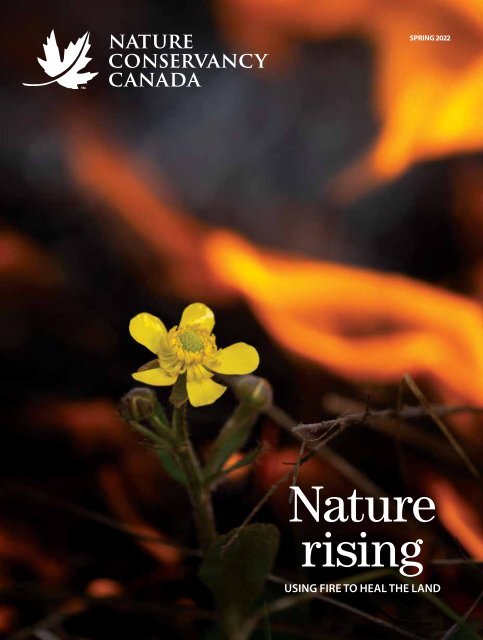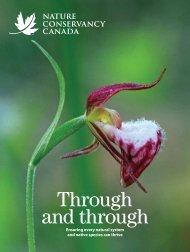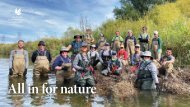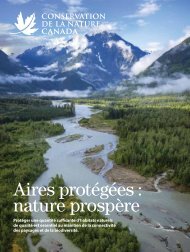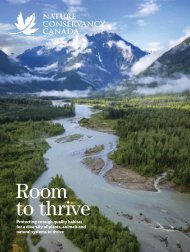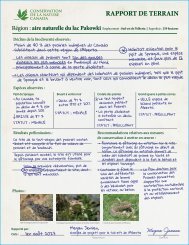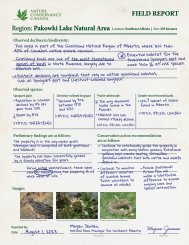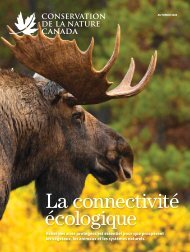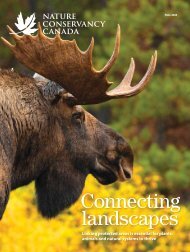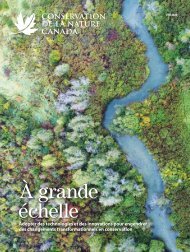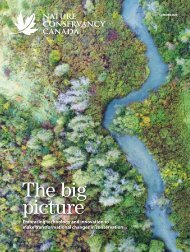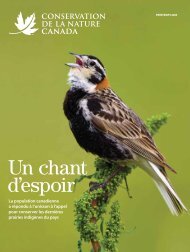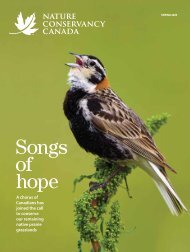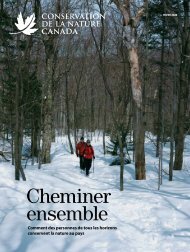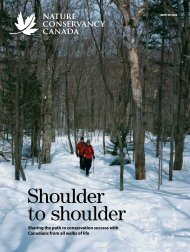NCC Magazine, Spring 2022
Create successful ePaper yourself
Turn your PDF publications into a flip-book with our unique Google optimized e-Paper software.
SPRING <strong>2022</strong><br />
Nature<br />
rising<br />
TKTKTKTKTKTKT<br />
USING FIRE TO HEAL THE LAND<br />
natureconservancy.ca<br />
WINTER 2021 1
Hastings Wildlife Junction, ON<br />
SPRING <strong>2022</strong><br />
CONTENTS<br />
Nature Conservancy of Canada<br />
4 Native plants for<br />
your garden<br />
Gardening with easy-to-grow plants.<br />
6 Pearson Township Wetland<br />
A wondrous wetland on Lake Superior’s<br />
North Shore.<br />
7 Bat signal<br />
How to help Canada’s declining<br />
bat populations.<br />
7 A natural fit<br />
Cataloguing the diversity of those<br />
who explore nature.<br />
8 Prescription to burn<br />
The paradox of fire.<br />
12 Bald eagle<br />
A showstopper of a bird.<br />
14 Wave of change<br />
Dax Dasilva is inspiring others to make<br />
a difference for nature.<br />
16 Project updates<br />
Plains bison re-established; grassland<br />
stewardship; Hastings Wildlife Junction.<br />
18 Hidden in plain sight<br />
The magical, endangered world of lichen.<br />
Digital extras<br />
Check out our online magazine page with<br />
additional content to supplement this issue,<br />
at nccmagazine.ca.<br />
Nature Conservancy of Canada<br />
245 Eglinton Ave. East, Suite 410 | Toronto, Ontario, Canada M4P 3J1<br />
magazine@natureconservancy.ca | Phone: 416.932.3202 | Toll-free: 877.231.3552<br />
The Nature Conservancy of Canada (<strong>NCC</strong>) is the country’s unifying force for nature. We seek solutions to the<br />
twin crises of rapid biodiversity loss and climate change through large-scale, permanent land conservation.<br />
<strong>NCC</strong> is a registered charity. With nature, we build a thriving world.<br />
The Nature Conservancy of Canada <strong>Magazine</strong> is distributed to donors and supporters of <strong>NCC</strong>.<br />
TM<br />
Trademarks owned by the Nature Conservancy of Canada.<br />
FSC is not responsible for any calculations on<br />
saving resources by choosing this paper.<br />
Printed on Enviro100 paper, which contains 100% post-consumer fibre, is EcoLogo, Processed Chlorine<br />
Free certified and manufactured in Canada by Rolland using biogas energy. Printed in Canada with vegetablebased<br />
inks by Warrens Waterless Printing. This publication saved 172 trees and 56,656 litres of water*.<br />
TKTKTKTKTKTKT<br />
GENERATED BY: CALCULATEUR.ROLLANDINC.COM. PHOTO: <strong>NCC</strong>. COVER: CHELSEA MARCANTONIO/<strong>NCC</strong> STAFF.<br />
*<br />
natureconservancy.ca
Nature champions<br />
Featured<br />
Contributors<br />
TKTKTKTKTKTKT<br />
TOP TO BOTTOM: PHOTO COURTESY OF DAWN CARR. CHEYENNE RAE; LUCY LU.<br />
Kootenay River Ranch<br />
Conservation Area, BC<br />
If there is one thing I’ve noticed since joining the Nature<br />
Conservancy of Canada (<strong>NCC</strong>) family in 2021, it’s the<br />
unwavering determination demonstrated by colleagues,<br />
partners and supporters to be champions for nature. I have<br />
found respite among caring, talented and passionate people who<br />
are working every day to make a tangible difference and positive<br />
contribution — locally, nationally and globally. I have also come<br />
to learn that <strong>NCC</strong>’s determination for nature’s sake is grounded<br />
in a deeply held belief that conservation action is a remedy to<br />
our world’s most pressing challenges. Conserving nature for the<br />
greater good is good medicine for all.<br />
As we collectively face the twin crises of biodiversity loss<br />
and climate change, there is growing recognition that Canadians<br />
need to share responsibility not only for conserving, but for<br />
caring for our natural areas for the long term.<br />
Last June, on World Environment Day, the United Nations<br />
kicked off the Decade on Ecosystem Restoration (2021–2030).<br />
The goal of this global movement is to “prevent, halt and reverse<br />
the degradation of ecosystems on every continent and in every<br />
ocean.” It could not have come at a more critical time, as humans<br />
have modified 77 per cent of terrestrial land (excluding<br />
Antarctica) and 87 per cent of oceans, globally. In this issue,<br />
you’ll read about the dramatic impact that fire can have in managing<br />
and restoring natural areas.<br />
As Canada embraces its global commitment to conserve<br />
nature by protecting 30 per cent of its lands and waters by 2030,<br />
<strong>NCC</strong> is in position to accelerate conservation. It’s so great to be<br />
part of a team who values and delivers conservation action for<br />
communities, with far-reaching benefits.<br />
Yours in nature,<br />
Dawn Carr<br />
Dawn Carr<br />
Director, strategic conservation, <strong>NCC</strong><br />
Susan Peters is a<br />
Winnipeg-based writer<br />
and editor. She wrote<br />
“Prescription to burn,”<br />
page 8, and her articles<br />
have appeared in<br />
Canadian Geographic,<br />
Report on Business and<br />
The Walrus.<br />
Lucy Lu is a freelance<br />
photographer whose<br />
work explores cultural<br />
identity, personal<br />
histories, and collective<br />
myths and memories.<br />
She photographed<br />
Micheline Khan for<br />
“A natural fit,” page 7.<br />
natureconservancy.ca<br />
SPRING <strong>2022</strong> 3
COAST TO<br />
COAST<br />
Native plants<br />
for your<br />
garden<br />
Beautify your garden and help local biodiversity with easyto-grow<br />
native plants suggested by our regional experts<br />
From coast to coast, frosty, hard ground is giving way to the green-up<br />
unfurling across the country. What better way to welcome the change of<br />
seasons than by preparing your planting space so you can look forward to<br />
a thriving garden? Whether you’re starting from scratch or expanding your<br />
gardening efforts, adding easy-to-grow native plants not only beautifies your<br />
yard or balcony, it also benefits your local ecosystem. Gardening is also a great<br />
opportunity to breathe in fresh air, move your body, focus on the physical<br />
environment and even see some wildlife.<br />
Before you plant, ask your local native plant nursery or regional native plant<br />
society for guidance on whether your plant choices are truly local to you.<br />
CHRISTOPHER PRICE / ALAMY STOCK PHOTO.<br />
4 SPRING <strong>2022</strong> natureconservancy.ca
IRINA NAOUMOVA / ALAMY STOCK PHOTO; ISTOCK; WIRESTOCK, INC. / ALAMY STOCK PHOTO; CHRISTOPHER PRICE / ALAMY STOCK PHOTO; AGEFOTOSTOCK / ALAMY STOCK PHOTO; DON JOHNSTON_PL / ALAMY STOCK PHOTO.<br />
Berryproducing<br />
plants<br />
Winter currant<br />
BC<br />
Winter currant is a deciduous<br />
shrub that does best in moist,<br />
well-drained soil. Native to BC’s<br />
south coast, this plant thrives in<br />
a sunny spot, but does tolerate<br />
some shade. Its drooping clusters<br />
of pink flowers attract butterflies,<br />
hummingbirds, songbirds and<br />
bees. The plant produces edible<br />
blue-black berries that are great<br />
for jams, syrups and pies.<br />
Canadian buffaloberry<br />
AB, BC, MB, NB, NL, NS, NT,<br />
NU, ON, QC, SK, YT<br />
Canadian buffaloberry is a native<br />
deciduous shrub found throughout<br />
North America, including<br />
the boreal forest, aspen parkland<br />
foothills and grassland regions.<br />
This hardy, medium-sized shrub<br />
(1–3 metres tall) will tolerate<br />
poor soil conditions. It produces<br />
attractive, edible — though<br />
bitter — red fruit, which is also<br />
a food source for small mammals<br />
and birds.<br />
Ground<br />
cover<br />
Canada anemone<br />
AB, BC, MB, NB, NL, NS, NT,<br />
NU, ON, PE, QC, SK<br />
Canada anemone is a<br />
low-maintenance perennial forb<br />
that produces cup-shaped white<br />
flowers. It grows in cool and<br />
humid woodlands and cool moist<br />
prairies, but can tolerate a variety<br />
of other types of soils. It makes<br />
a nice ground cover on its own or<br />
among milkweeds and between<br />
shrubs, but can spread in gardens<br />
and create full ground cover.<br />
Canada anemone attracts bees<br />
and other pollinators, as well as<br />
predatory wasps, which control<br />
common insect pests.<br />
Ostrich fern<br />
AB, BC, MB, NB, NL, NS, NT,<br />
ON, PE, QC, SK, YT<br />
Ostrich fern does best in moist,<br />
relatively rich sites, full sun or full<br />
shade, but may spread aggressively.<br />
This plant will grow under the<br />
dense, maple-heavy canopies<br />
of urban backyards or in rain<br />
gardens. It can be planted as<br />
borders by streams or ponds.<br />
Young fronds can be harvested<br />
and eaten, if cooked properly,<br />
before they unfurl; the taste is<br />
comparable to asparagus.<br />
Beautiful<br />
blooms<br />
Great blanket-flower<br />
AB, BC, MB, SK<br />
In the mixed grassland region,<br />
great blanket-flower is a<br />
herbaceous perennial that<br />
tolerates well-drained, nutrient-poor<br />
soil. It blooms all<br />
summer, with flowers that<br />
last a long time. It is easy to find<br />
the native variety (as seeds and<br />
plants) in local nurseries. Both<br />
bees and butterflies (and other<br />
pollinators) use this plant. The<br />
entire plant is covered in fuzzy<br />
hairs, which can be an irritant<br />
for some people.<br />
White turtlehead<br />
MB, NB, NL, NS, ON, PE, QC<br />
White turtlehead is found in wet<br />
locations in the wild, but adapts<br />
well to average garden soils if<br />
kept watered. The species grows<br />
in partial sun, and moist to wet<br />
gardens, and blooms from late<br />
summer to fall. Plants divide and<br />
transplant readily, and once<br />
established are virtually troublefree.<br />
They are a good late-season<br />
nectar source for pollinators and<br />
the primary host plant for<br />
Baltimore checkerspot butterfly.<br />
Shrubs<br />
Choke cherry<br />
AB, BC, MB, NB, NL, NS, NT,<br />
ON, PE, QC, SK<br />
Choke cherry is a shrub that<br />
can grow up to six metres tall.<br />
It produces clusters of red<br />
cherries that are very sour but<br />
edible. Choke cherry does best<br />
in rich, well-drained soil and can<br />
grow under light shade to full<br />
sun. The fruits are a preferred<br />
food source for a variety of birds,<br />
including pileated woodpecker,<br />
eastern bluebird and cedar<br />
waxwing. Mammals, such as red<br />
fox, skunk and chipmunk, may<br />
also browse the twigs and buds<br />
for food. This plant is resistant<br />
to salt and can be planted along<br />
shorelines or roadsides.<br />
Oblong-leaf<br />
serviceberry<br />
NB, NS, PE, QC<br />
Oblong-leaf serviceberry,<br />
also known as chuckleberry,<br />
is a deciduous shrub with<br />
edible dark-purple berries. It’s<br />
an excellent early flower for<br />
pollinators. Many bird species<br />
feed on its berries, as they are an<br />
important food source before<br />
migration. This shrub grows well<br />
in a variety of conditions and is<br />
resistant to air pollution.<br />
BEST TIME TO GET PLANTS IN THE GROUND<br />
A general rule of thumb is to wait until after the last frost to plant native flowers and grasses. In some parts of<br />
the country, this can be as early as April, while in other areas it may be late May. If you’re starting from seed,<br />
some native species require a cold–moist stratification (when seeds go through a period of cold temperatures)<br />
to break the seed’s dormancy. You can mimic these conditions at home using moist, sterile substrate (such as<br />
perlite) in a sealed bag in the refrigerator (ideally a few weeks before the last frost).<br />
natureconservancy.ca<br />
SPRING <strong>2022</strong> 5
BOOTS ON<br />
THE TRAIL<br />
<strong>NCC</strong><br />
Nature Reserve<br />
P<br />
★<br />
Pearson Township Wetland<br />
Conservation Reserve<br />
Hwy 597<br />
<br />
N<br />
★<br />
★<br />
<strong>NCC</strong><br />
Nature Reserve<br />
<strong>NCC</strong><br />
Nature Reserve<br />
Chestnut-sided warbler<br />
★<br />
Roundleaf sundew<br />
Starflower<br />
North American river otter<br />
<br />
N<br />
Beaver<br />
Pearson Township<br />
Wetland<br />
A wondrous wetland on Lake Superior’s North Shore<br />
The Pearson Township Wetland, located within<br />
the Nature Conservancy of Canada’s (<strong>NCC</strong>’s) Lake<br />
Superior Coast Natural Area in Neebing, Ontario,<br />
measures 739 hectares. Much of it is protected as<br />
a conservation area, including 130 hectares by <strong>NCC</strong>.<br />
Volunteers contributed over 150 hours to clear<br />
the trails and install signage. The six-kilometre<br />
Pearson Township Wetland Nature Trail is located<br />
on Crown land, and overlooks <strong>NCC</strong>’s Pearson<br />
Township Wetland Nature Reserve.<br />
Located in the headwaters of the Pine River, this<br />
large wetland provides critical habitat for a variety<br />
of wildlife, such as American river otter and beaver.<br />
Back in the mid-1990s, Gary Davies, now retired<br />
from his position as <strong>NCC</strong>’s program director for<br />
northwestern Ontario, dreamed of creating a trail<br />
that overlooked the Provincially Significant Wetland.<br />
The goal was to create an enjoyable and educational<br />
experience for visitors.<br />
Thanks to the generous contributions of volunteers<br />
and donors, Davies’ vision became a reality.<br />
The trail climbs from the parking area to a loop<br />
atop the mesa, with stunning views overlooking<br />
the wetland. The trail is steep in sections, ranging<br />
in difficulty from moderate to difficult.<br />
STAY SAFE<br />
Please stay safe and respect local health directives<br />
when visiting <strong>NCC</strong> properties.1<br />
LEARN MORE<br />
natureconservancy.ca/pearsonwetland<br />
LEGEND<br />
-- Trail<br />
★ Lookout<br />
P Parking<br />
SPECIES TO SPOT<br />
• American redstart<br />
• black bear<br />
• chestnut-sided<br />
warbler<br />
• fisher<br />
• ghost pipe<br />
• magnolia warbler<br />
• moose<br />
• North American<br />
river otter<br />
MAP: JACQUES PERRAULT. PHOTOS: ROBERT MCCAW.<br />
6 SPRING <strong>2022</strong> natureconservancy.ca
ACTIVITY<br />
CORNER<br />
BACKPACK<br />
ESSENTIALS<br />
Be batty<br />
Shine the bat signal and do<br />
your part to help Canada’s<br />
declining bat populations<br />
PHOTO: LUCY LU. ILLUSTRATION: BELLE WUTHRICH.<br />
Bats may be commonly associated with a certain<br />
superhero, but these often-misunderstood<br />
mammals are facing many threats, including<br />
habitat loss and a fast-spreading fungal disease<br />
called white-nose syndrome.<br />
Here are a few things you can do to help bats<br />
(find out more at natureconservancy.ca/bats):<br />
1. Build and install a bat box near your<br />
home, with just a few tools and some easy-tosource<br />
materials.<br />
2. Become a bat watcher by converting your<br />
smartphone into a bat detector.<br />
3. If you have to remove bats from your<br />
house, use humane practices and/or keep<br />
them from re-entering your home.<br />
4. Find out more about the bat species in your<br />
neighbourhood, and your share your story on<br />
social media with the hashtag #MySmallAct.<br />
<strong>NCC</strong> is protecting habitat for bats across Canada.<br />
We are also monitoring bat populations on our<br />
properties, and working with the Toronto Zoo<br />
on their Native Bat Conservation Program.<br />
Find out more about these small acts and<br />
how you can help bats in your neighbourhood<br />
at natureconservancy.ca/bats.<br />
A natural fit<br />
Ecologist Micheline Khan catalogues the sights of nature<br />
and the diversity of those who explore it<br />
Ihave always been fascinated by nature. I would venture into the woods near my<br />
childhood home, teeming with life, reeds tall and stately and standing guard<br />
over marshy ponds, salamanders creeping under dark, dank rocks as songbirds<br />
soared and dipped with an exhilarating freedom. It was natural that I would become<br />
an ecologist, that I would make a space for myself where there were few<br />
others who looked like me. I remember the first time I did field work in Algonquin<br />
Park, I all but forced two graduate researchers to let me volunteer with them. The<br />
curious, sometimes derisive stares when we went into town did nothing to dampen<br />
my resolve. I didn’t quite fit the mold, to some. The researchers, however, recognized<br />
a kindred spirit and welcomed me into their homes. As we ventured out into<br />
the forests and onto the lakes with our canoes, I began to appreciate and be in awe<br />
of how tremendously vast these spaces were.<br />
My goal then and there was to make nature more accessible to underserved<br />
communities so that they know they deserve access to these spaces too. There is<br />
beauty here, undiscovered, underappreciated, in hard-to-find nooks and crannies.<br />
So, my backpack carries an old Fujifilm camera my dad gifted me; what I need to<br />
capture and convey not only the sights of nature but the diverse people who work<br />
in and explore it. I catalogue us so that younger generations will know they<br />
belong here too.1<br />
natureconservancy.ca<br />
SPRING <strong>2022</strong> 7
Prescription<br />
burn<br />
to<br />
The paradox of fire: How something so<br />
destructive can benefit the landscape<br />
BY Susan Peters<br />
TKTKTKTKTKTKT<br />
CHELSEA MARCANTONIO/<strong>NCC</strong> STAFF.<br />
8 SPRING <strong>2022</strong> natureconservancy.ca
Fire has been used to manage the<br />
landscape for thousands of years.<br />
Standing over the flames with<br />
shovels and backpack sprayers of water,<br />
ready to stamp out stray embers, the burn<br />
crew watches the fire they’ve set. “Especially<br />
when it’s a boring burn, it’s fun,” says Julie<br />
Sveinson Pelc, the incident commander in charge of the<br />
fire. “Boring means we’re standing and looking at fire. It<br />
means things are going exactly as they should,” she explains<br />
as, during a COVID-19 surge in the height of winter,<br />
she shows photos of a planned burn that happened last<br />
September at the Tall Grass Prairie Preserve in southeastern<br />
Manitoba, where the scent of burning grasses can<br />
resemble essential oils.<br />
Although North America has a recent history of fire<br />
suppression, fire was used to manage landscapes for thousands<br />
of years prior to European settlement. For several<br />
decades, Nature Conservancy of Canada (<strong>NCC</strong>) staff have<br />
been bringing back fire in an intentional way to manage<br />
the organization’s conservation lands, from BC to Saskatchewan<br />
and Manitoba, and even the grasslands of Ontario.<br />
Particularly in prairie regions, the plants and animals<br />
we have today — and the ones we want for tomorrow, too<br />
— evolved to thrive in an ecosystem that experienced<br />
regular disturbances, such as grazing, burning, flooding<br />
and drought.<br />
With 20 years of burn experience, Pelc, who manages<br />
<strong>NCC</strong>’s stewardship program in Manitoba, can debate the<br />
merits of a light, surface burn versus a high-intensity fire:<br />
“It can boil the trees: you can see the fluids bubbling.”<br />
The fire was intended to contribute to the ongoing restoration<br />
of a 20-hectare area of grassland that is prime habitat<br />
for endangered monarch butterflies. It removed willows<br />
and other woody shrubs that were growing in the<br />
grasses and that would turn the wide, open land into a<br />
woods of aspen and bur oak, if left unchecked. Fires burn<br />
dry grasses and leaves, returning those nutrients to the<br />
soil and leaving the earth open for rain to sink in. Burning<br />
the area that had previously been seeded will grow more<br />
of the plants that feed monarch butterfly caterpillars<br />
and adults.<br />
natureconservancy.ca<br />
SPRING <strong>2022</strong> 9
Clockwise from left: Julie Sveinson Pelc communicating<br />
prescribed fire activity with the crew at the Tall Grass Prairie<br />
Preserve; fire crew members overseeing burn; Rice Lake Plains.<br />
These fires are set with a “prescription” to<br />
burn, meaning professionally managed, intentionally<br />
set fires that burn in a pre-determined<br />
area, under strictly controlled circumstances<br />
for the sole purpose of restoring natural habitat<br />
(a different kind of burn happens in agriculture<br />
when farmers burn crop stubble after<br />
harvest). Planning for prescribed burns involves<br />
consulting a decision-making tool<br />
called the Multiple Species at Risk Recovery,<br />
Management and Research (Multi-SAR) plan<br />
to determine the best time of year to burn to<br />
support a species, such as endangered prairie<br />
white-fringed orchids or Poweshiek skipperling<br />
butterflies. It means assessing the dryness<br />
on the ground, relative humidity, wind<br />
and temperature, getting burn permits from<br />
the municipality or province, and doing outreach<br />
to fire departments and neighbours who<br />
might have concerns that an out-of-control<br />
fire could destroy their homes or ranches.<br />
When <strong>NCC</strong> undertakes prescribed burns,<br />
they’re usually done to decrease dry plant<br />
litter build-up and prevent woody tree species<br />
from overtaking a prairie or grassy area,<br />
as at the Tall Grass Prairie Preserve, although<br />
there are also plans to use fire to clear the<br />
understory in open forests like those at the<br />
Darkwoods Conservation Area in BC. Across<br />
North America, controlled burns are managed<br />
by federal and provincial parks services,<br />
Indigenous communities and municipalities,<br />
sometimes to prevent out-of-control forest<br />
fires. “When fuel loads build up, the fires can<br />
be hotter, cover bigger areas — it can be<br />
devastating. Some groups burn to avoid the<br />
risk of catastrophic fire, to make sure humans<br />
aren’t at risk,” says Sam Knight, <strong>NCC</strong>’s Weston<br />
Family Science Program manager, and<br />
also a conservation biologist who manages the<br />
organization’s national conservation research<br />
program. “A lot of ecosystems are adapted to<br />
fire and need disturbances, like grazing and<br />
fire, to be maintained.”<br />
Under control<br />
The September burn in Manitoba saw the<br />
crew of 10 workers on a mowed fire guard of<br />
grass in a large square lay a trail of water<br />
along the fire lines. They then used specialized<br />
drip torches to light the burn line, creating<br />
a triple line of defense against a fire escaping<br />
their control. “People like to brag about<br />
how straight their burn lines are,” Pelc shrugs,<br />
but she’s proud of how the crew of new and<br />
experienced <strong>NCC</strong> staff in personal protective<br />
equipment, such as leather boots and gloves,<br />
fire suits, masks and safety glasses, moves in<br />
slow and unhurried cooperation to complete<br />
the backing burn line against the wind, before<br />
the head fire is lit with the wind to dramatically<br />
sweep across the centre of the section.<br />
A lifelong Manitoban, Pelc’s first fire happened<br />
at the preserve when she was a master’s student<br />
in botany who volunteered to look out<br />
for embers that crossed the fire guard. She<br />
now burns there professionally and at two<br />
<strong>NCC</strong> properties in Manitoba within the mixedgrass<br />
prairie: Yellow Quill and Fort Ellice.<br />
Farther east, prescribed burns have been<br />
happening for the past decade near Peterborough,<br />
Ontario, at the Rice Lake Plains Natural<br />
Area. The tall grass prairie and black oak<br />
savannah in the area are managed in partnership<br />
with other conservation organizations,<br />
TOP TO BOTTOM: <strong>NCC</strong>; CHELSEA MARCANTONIO/<strong>NCC</strong> STAFF; CHELSEA MARCANTONIO/<strong>NCC</strong> STAFF.<br />
10 SPRING <strong>2022</strong> natureconservancy.ca
LEFT TO RIGHT: <strong>NCC</strong>; CHELSEA MARCANTONIO/<strong>NCC</strong> STAFF.<br />
including Alderville First Nation. The Alderville<br />
black oak savannah is “true remnant<br />
prairie,” according to Val Deziel, coordinator<br />
of conservation biology in Ontario for <strong>NCC</strong>.<br />
“In the last 10 years, we’ve focused our efforts<br />
in the area on not only conservation, but<br />
the restoration of land,” says Deziel, whose<br />
work includes supervising fires run by a private<br />
contractor. Thinning trees with a chainsaw,<br />
along with prescribed burns, helps to<br />
keep grasslands open. “Woodpeckers love the<br />
burns — if there’s a tree that’s half dying and<br />
full of insects, like an old pine, the birds will<br />
fly in and get fat on the insects after the fire<br />
finishes off the tree,” says Deziel. She grew<br />
up in the area and can tell you how, before<br />
colonization, people conducted burns to grow<br />
medicinal plants along with lush, green grass<br />
to attract grazing animals for hunters. As we<br />
enter the second year of the UN Decade on<br />
Restoration (2021–2030), fire is a dramatic<br />
example of how we can play a role in managing<br />
and healing nature for the long term.<br />
Another place where controlled burns<br />
are occurring on <strong>NCC</strong> lands is in BC. At the<br />
Cowichan Garry Oak Preserve on Vancouver<br />
Island, prescribed burns in these Garry oak<br />
meadows not only lower the risk of wildfires,<br />
but also control invasive plants and promote<br />
the growth of fire-adapted native species.<br />
The timing of when fires should be prescribed<br />
remains an important decision for <strong>NCC</strong> in BC,<br />
where dry summers increase the risk of extreme<br />
wildfires. Burns take place in autumn<br />
when wildfire risk is low. When burns do take<br />
place at the Cowichan Garry Oak Preserve,<br />
they are often low-intensity fires, which don’t<br />
burn very hot. “Five minutes after the fire<br />
passes, the ground is cool enough to touch,”<br />
says Ginny Hudson, manager of conservation<br />
planning and stewardship for <strong>NCC</strong> in BC.<br />
These types of meadows have been traditionally<br />
managed with fire by Indigenous people<br />
for thousands of years. One purpose for the<br />
burns here is to promote the growth of cultural<br />
food plants like camas, which have sweet<br />
tasting roots that can be baked or dried.<br />
<strong>NCC</strong>’s goal is to work more closely with local<br />
Indigenous people on burns, as happens at<br />
Rice Lake Plains in Ontario.<br />
Medicine for the land<br />
Around the world and within North America,<br />
fires are part of how many Indigenous<br />
Peoples manage the landscape. Amy Cardinal<br />
Christianson is a fire social scientist with Canadian<br />
Forest Service, a co-host of the podcast<br />
Good Fire and a Métis woman. She has also<br />
authored Blazing the Trail: Celebrating Indigenous<br />
Fire Stewardship. “When settlers<br />
came to Canada, they brought a European<br />
idea of forest management. The idea was to<br />
protect timber. They saw fire as a risk to forests.”<br />
Christianson distinguishes between<br />
cultural burns — low-intensity, slow burns<br />
on a small piece of land for cultural reasons,<br />
which she calls ”medicine for the land” — and<br />
prescribed burns, which she describes as<br />
usually hot, high-intensity burns that cover<br />
large areas to reduce fuel or to clear land for<br />
ecological reasons. Christianson says barriers,<br />
such as the training and certification required,<br />
don’t recognize Indigenous ways of knowing.<br />
She would like to see more Indigenous people<br />
involved and more local autonomy in burning<br />
decisions. “Over the next 10 years, hopefully<br />
the communities and wildfire management<br />
agencies can work together,” she adds.<br />
Meanwhile, at the September burn at the<br />
Tall Grass Prairie Preserve, the result could<br />
be seen the next day. Pelc describes islands<br />
of intact grass left behind in a black ocean of<br />
soot, where the patches of native grasses will<br />
regrow from their roots, newly reinvigorated.<br />
“As the leader, I find a burn somewhat intense,<br />
but I find it rewarding after it’s finished,” says<br />
Pelc. The local fire chief stopped by and<br />
checked out the new two-way radios that the<br />
burn crew had purchased on his recommendation,<br />
while neighbours slowed down to<br />
wave as they drove past. In 2021, Pelc led the<br />
crew on eight prescribed fires that covered<br />
167 hectares, the most in the last 10 years<br />
that <strong>NCC</strong> has burned in Manitoba. Pelc is already<br />
planning for spring: after the fire crew<br />
renew their training, as soon as the snow<br />
melts, it’s dry enough and the wind is low,<br />
Fort Ellice is due for a good burn.1<br />
As we enter the second year of the<br />
UN Decade on Restoration (2021–2030),<br />
fire is a dramatic example of how<br />
we can play a role in managing and<br />
healing nature for the long term<br />
natureconservancy.ca<br />
SPRING <strong>2022</strong> 11
SPECIES<br />
PROFILE<br />
Bald eagle<br />
With a wingspan of more than two metres, this regal bird is a showstopper<br />
JUNIORS BILDARCHIV GMBH / ALAMY STOCK PHOTO.<br />
12 SPRING <strong>2022</strong><br />
natureconservancy.ca
APPEARANCE<br />
This bird is far from bald; it derives its name<br />
from the word “piebald,” meaning “patches of two<br />
different colours,” in reference to the eagle’s white head<br />
and tail, and dark brown body.<br />
Spanning more than two metres, a bald eagle’s wings<br />
are made for soaring. This species can measure about<br />
76 centimetres in height and weigh three to seven kilograms.<br />
Female bald eagles are typically larger than males.<br />
Bald eagles feast on the Squamish River<br />
Plumage on male and female bald eagles is identical.<br />
Adults have a dark brown body with white feathers<br />
on their head and tail. Their beaks are yellow, as are their<br />
legs. Juvenile bald eagles have mostly dark heads and<br />
tails, and are often mistaken for turkey vultures or<br />
golden eagles. It takes four to five years for<br />
them to reach adult colouration.<br />
RANGE<br />
Bald eagles are distributed from<br />
coast to coast, ranging from Canada’s<br />
boreal forest to northern Mexico, a range of<br />
approximately 2.5 million square kilometres.<br />
Much of Canada’s bald eagle population lives in<br />
coastal British Columbia, with inland populations<br />
found in boreal forests across the country, as well as<br />
populations in Nova Scotia and Newfoundland.<br />
Bald eagles rely on forested areas close to lakes,<br />
rivers, marshes and coastal habitats. In<br />
winter, bald eagles can be found in<br />
parts of southern Canada.<br />
What <strong>NCC</strong> is doing<br />
to protect habitat for<br />
this species<br />
Since the 1990s, <strong>NCC</strong> has been at<br />
the forefront of efforts to protect<br />
core habitat for the largest recorded<br />
concentration of wintering bald<br />
eagles in North America. In the small<br />
community of Brackendale, BC, just<br />
north of Vancouver, bald eagles congregate<br />
by the thousands from November<br />
to March to feast on the abundant<br />
salmon spawning in the Squamish and<br />
Cheakamus rivers. In partnership with<br />
the Cheakamus Centre, an outdoor<br />
environmental education centre, <strong>NCC</strong><br />
placed a conservation agreement on<br />
the centre’s 170-hectare property along<br />
the Cheakamus River, ensuring protection<br />
of its old-growth forest and salmon-rich<br />
riverfront in perpetuity.<br />
<strong>NCC</strong> also participated in a campaign<br />
to educate the public about how<br />
to respectfully view the eagles of<br />
Brackendale, which included the<br />
construction of a viewing shelter and<br />
interpretive signs. The Eagle Count is<br />
a popular event, dating back to at least<br />
1986, when the community gathers in<br />
January to watch the birds.1<br />
THREATS<br />
PHOTO: GUNTER MARX / WI / ALAMY STOCK PHOTO. ILLUSTRATIONS: CORY PROULX.<br />
Bald eagles are currently not listed as<br />
an at-risk species and have healthy<br />
populations throughout most of their range,<br />
but this was not always the case. Historically,<br />
the species declined as a result of habitat loss and<br />
unintentional DDT poisoning. Public education,<br />
habitat conservation and regulations have helped<br />
bald eagle populations recover. Today, researchers,<br />
conservation groups and community<br />
science programs continue to monitor<br />
these impressive birds.<br />
HELP OUT<br />
Help protect habitat<br />
for species at risk at<br />
giftsofnature.ca.<br />
HABITAT<br />
Bald eagles breed in forested<br />
areas near large bodies of water, such<br />
as ocean coasts and lakeshores. They<br />
prefer tall, mature trees for perching;<br />
this provides them with a wide view of<br />
their surroundings.<br />
In winter, bald eagles can be found<br />
in areas with open water for fishing,<br />
as fish constitute the majority of<br />
their diet.<br />
natureconservancy.ca<br />
SPRING <strong>2022</strong> 13
FORCE FOR<br />
NATURE<br />
Wave<br />
of change<br />
Dax Dasilva, founder of e-commerce platform Lightspeed,<br />
is inspiring others to make a difference for nature<br />
GUILLAUME SIMONEAU.<br />
14 SPRING <strong>2022</strong><br />
natureconservancy.ca
Five minutes from Dax Dasilva’s office in Quebec<br />
flows a natural treasure that nurtures life as big as<br />
humpbacks and as small as tiny krill. It’s also a major<br />
throughway for wildlife and humans that, perhaps, not enough<br />
people have appreciation for: the St. Lawrence River.<br />
“Nature is a big part of my life. It always reminds me of how precious<br />
and vulnerable it is to humanity’s never-ending expansion,” says Dax<br />
Dasilva, founder of e-commerce platform Lightspeed and the non-profit<br />
environmental alliance Age of Union. He attributes his deep connection<br />
to nature to his upbringing on the West Coast, where he had access to<br />
beautiful landscapes. But no matter where he has travelled and settled,<br />
hiking and adventuring have always been a part of his lifestyle.<br />
“Given my early exposure to nature, I felt that when I had the resources<br />
and platform, I would be doing as much as I could to further<br />
conservation,” says Dasilva. “I think people look to tech leaders and<br />
how they approach challenges like humanity’s impact on the future.<br />
For me, there’s no more important way [to be a leader] than by protecting<br />
our planet and its species.”<br />
This vision for safeguarding nature motivated Dasilva to form Age<br />
of Union, a non-profit alliance that supports those working to protect<br />
our planet’s threatened species and ecosystems. He is now on a path<br />
to support tangible conservation projects in his province and around<br />
the world through contributions from like-minded business leaders<br />
and conservation organizations.<br />
If we see positive examples that we can<br />
relate to, where we’re moving the needle,<br />
we will feel the goal is within reach. We<br />
can make impacts every day.<br />
SUPPORTING CONSERVATION ALONG THE<br />
ST. LAWRENCE RIVER<br />
The St. Lawrence River is one of the world’s largest freshwater reserves.<br />
It flows into the St. Lawrence Estuary where fresh water and salt water<br />
meet, eventually emptying into the Gulf of St. Lawrence, which opens<br />
to the Atlantic Ocean. Its entire length (1,197 kilometres) teems with<br />
life that remains productive all year long. Dasilva saw this majestic river<br />
up close during site visits with the Nature Conservancy of Canada’s<br />
(<strong>NCC</strong>’s) Joël Bonin, associate regional vice president in Quebec.<br />
“Just an hour away from Montreal, you have the floodplains of<br />
the St. Lawrence, which look like the Florida Everglades. When we<br />
documented all the wildlife close to where [people] live, it is incredibly<br />
humbling. Seeing this first-hand motivates you to do everything you<br />
can to safeguard life here,” explains Dasilva.<br />
As Bonin and Dasilva threaded a boat through the small channels<br />
of the St. Lawrence River delta on a recent visit, they observed the<br />
interconnected life along its shorelines, islands and wetlands. Fish<br />
here rely on river bottoms for spawning. These areas can be at risk<br />
from deforested floodplains, whose exposed soil can get dragged into<br />
the freshwater ecosystem during natural cycles of flooding. The health<br />
of the wetlands along the river is also vital to maintaining nature’s<br />
filtration system, sustaining both humans and wildlife.<br />
Protecting these waters and lands requires<br />
a collective effort, or union, as Dasilva<br />
calls it. This is where Age of Union can<br />
contribute to <strong>NCC</strong>’s work in protecting these<br />
habitats, by supporting restoration activities,<br />
cleaning shorelines, reforesting flood plains<br />
and more.<br />
With support from the alliance, <strong>NCC</strong> has<br />
helped protect more than 205 hectares, restored<br />
over 15 hectares, completed planting<br />
over 1,700 plants and helped recover 32 species<br />
at risk. This included restoration work<br />
on the sandbars of Barachois-de-Malbaie,<br />
where vegetation was planted to reduce natural<br />
erosion and restore degraded areas.<br />
Phragmites control is also well underway at<br />
Île aux Grues, approximately 80 kilometres<br />
from Quebec City, with a plan to halt this<br />
invasive reed’s spread on the island.<br />
The alliance’s funding also contributed<br />
to the protection of over 200 hectares at<br />
the western end of the Montreal Green Belt,<br />
with 1.6 kilometres of shoreline on Rivierè<br />
du Nord: habitat for at-risk northern map<br />
turtles (one of 17 at-risk species protected<br />
through this new acquisition).<br />
“It’s time to shift from going about your<br />
day-to-day life on autopilot to a mindset<br />
that centres around sharing the planet. We<br />
have to think about ourselves as guardians<br />
instead of consumers,” reflects Dasilva.<br />
When asked about his thoughts on inspiring<br />
others, Dasilva says: “Doom and gloom is not<br />
going to motivate people. If we see positive<br />
examples that we can relate to, where we’re<br />
moving the needle, we will feel the goal is<br />
within reach. We can make impacts every<br />
day. Everyone has a unique ability to do<br />
something positive for nature — we can<br />
be changemakers.”<br />
This power of union — with people, and<br />
with nature — is what will motivate positive<br />
change in an age of climate emergency. Business<br />
leaders like Dasilva are hoping that by<br />
showcasing action-oriented causes and their<br />
impacts, sharing people’s stories and leveraging<br />
partnerships, more changemakers will<br />
start their own small actions for nature.<br />
“I’m hoping others will find projects<br />
they feel close to and follow our example,”<br />
Dasilva says confidently.1<br />
natureconservancy.ca<br />
SPRING <strong>2022</strong> 15
PROJECT<br />
UPDATES<br />
1<br />
Plains bison herd successfully<br />
re-established to The Key First Nation<br />
SASKATCHEWAN<br />
1<br />
2<br />
THANK YOU!<br />
Your support has made these<br />
projects possible. Learn more at<br />
natureconservancy.ca/where-we-work.<br />
3<br />
Mashkode-bizhiki/plains bison are an iconic symbol of the<br />
grasslands. Indigenous people in North America subsisted<br />
on bison for thousands of years, but European colonization<br />
swiftly drove the bison populations to near extinction through<br />
unsustainable hunting pressure.<br />
Recently, a total of 20 plains bison from Grasslands National Park<br />
and 20 from Old Man on His Back Prairie and Heritage Conservation<br />
Area (OMB) in Saskatchewan were successfully translocated to The<br />
Key First Nation’s (TKFN’s) lands in Treaty 4. With this transfer of<br />
bison, TKFN, Parks Canada and <strong>NCC</strong> are working in collaboration toward<br />
the survival and well-being of these iconic and majestic animals.<br />
The return of mashkode-bizhiki to TKFN advances Indigenous-led<br />
conservation in this area, including managing the herd through Indigenous<br />
ecological knowledge, creating and strengthening relationships between<br />
Nations and stakeholders, and sustaining cultural and socio-economic<br />
opportunities for Indigenous community members.<br />
Chris Gareau, councillor with TKFN and a member of the <strong>NCC</strong><br />
Indigenous Advisory Group in Saskatchewan, noted: “The return of<br />
Bison to TKFN has fostered unity within the community and, most<br />
importantly, an atmosphere for healing, [with] the unlimited benefits<br />
shared by all. Our ancestors relied heavily on Bison for their survival<br />
and well-being, utilizing every part of the Bison for food, clothing,<br />
shelters, tools, implements and in a variety of ceremonies.”<br />
Restoring threatened species to Indigenous Nations is an important<br />
step on the pathway toward Reconciliation. This February, the Honourable<br />
Steven Guilbeault, minister of environment and climate change<br />
and minister responsible for Parks Canada, and Jennifer McKillop, Saskatchewan<br />
regional vice-president for <strong>NCC</strong>, were present at a celebration<br />
of the translocation of the 40 plains bison to establish a new herd<br />
with TKFN.<br />
MARK TAYLOR; INSET: PARKS CANADA.<br />
The recovery of mashkode-bizhiki/plains bison to Indigenous Nations<br />
is an important step on the pathway toward Reconciliation.<br />
16 SPRING <strong>2022</strong><br />
natureconservancy.ca
Marsh Ranch, Alberta<br />
Wild + Pine staff<br />
tree planting on<br />
prepped site.<br />
2<br />
Grassland stewardship keeping the prairie healthy<br />
THE PRAIRIES<br />
Partner Spotlight<br />
L TO R: CARYS RICHARDS/<strong>NCC</strong>; <strong>NCC</strong>; MAIDA TANWEER.<br />
A new collaboration, the largest ever in support of grassland stewardship in Canada’s Prairie provinces, aims<br />
to care for unique and threatened grassland ecosystems in Alberta, Saskatchewan and Manitoba. Home to<br />
rare and endangered plant and animal species, grasslands sequester carbon, filter water and stabilize soil.<br />
Over the next few years, <strong>NCC</strong>, in cooperation with four land trusts in Canada's prairies, will administer<br />
the Stewardship Investment Program, part of the Weston Family Prairie Grasslands Initiative.<br />
The program, launched in June 2021, will impact the plant and wildlife biodiversity of up to 1.4 million<br />
hectares of grasslands, through the delivery of up to 800 individual grants. Livestock producers with<br />
conservation agreements with <strong>NCC</strong>, community pastures, and individuals renting lands from <strong>NCC</strong> and<br />
other land trusts can apply for funding to implement a range of projects that support the conservation<br />
of biodiversity on rangelands, from installing wildlife-friendly fencing to installing solar powered remote<br />
watering systems.<br />
Empowering ranchers — the primary owners and managers of the remaining grasslands — with stewardship<br />
tools, incentives, education and support will encourage the adoption of management practices<br />
that support biodiversity. Improving the use and productivity of grasslands will ensure that all its inhabitants<br />
are sustained, and can reduce the risk of further grassland loss.<br />
3<br />
Final push to protect once-in-a-lifetime<br />
landscape<br />
SOUTHERN ONTARIO<br />
<strong>NCC</strong> is working on a major conservation project to help protect<br />
and care for 8,000 hectares near Bancroft, Ontario.<br />
Hastings Wildlife Junction provides some of the best<br />
remaining habitat for many species at risk and wide-ranging<br />
mammals, including elk, birds and turtles. Located within<br />
the Lake Ontario watershed and headwaters for the Bay of<br />
Quinte, the project is particularly critical for maintaining the<br />
water quality for local aquatic life and communities on the<br />
coast of Lake Ontario. Vast amounts of carbon are stored in<br />
its forests and wetlands.<br />
<strong>NCC</strong> is the only organization of its kind working in Canada<br />
to deliver this scale of conservation impact, with a proven<br />
track record of connecting, conserving and caring for vast<br />
natural areas.<br />
To date, 5,000 hectares of the Hastings Wildlife Junction<br />
have been protected, but there is more to be done. <strong>NCC</strong>’s goal<br />
is to conserve 8,000 hectares of intact forest and wetlands here.<br />
Join us in this historic effort by making a one-time gift or multiyear<br />
pledge to ensure the future of Hastings Wildlife Junction.<br />
Learn more at natureconservancy.ca/hastings.<br />
Hastings Wildlife Junction<br />
Wild + Pine Sustainability has<br />
been working in ecosystem<br />
restoration across Canada<br />
for more than a decade.<br />
Using eco-technology to grow<br />
seedlings in their custom<br />
greenhouse, they are able to<br />
mimic the light and conditions<br />
found in the ecosystems where<br />
the seedlings will eventually<br />
be planted.<br />
In 2020, Wild + Pine<br />
approached the Nature<br />
Conservancy of Canada (<strong>NCC</strong>)<br />
and offered to design and<br />
implement a crowd-funded<br />
project. This project allowed<br />
Canadian businesses that<br />
balance purpose and profit by<br />
considering the impact of their<br />
work to fund the reforestation<br />
and restoration of 25 hectares<br />
of former agricultural land on<br />
an <strong>NCC</strong> property in Central<br />
Alberta. In 2021, Wild + Pine<br />
prepped the site and planted<br />
52,000 seedlings of trembling<br />
aspen, balsam poplar, paper<br />
birch, white spruce and larch,<br />
along with complementary<br />
shrub species. Another 5,000<br />
seedlings will be planted in<br />
<strong>2022</strong>, and <strong>NCC</strong> volunteers will<br />
help weed the newly planted<br />
site to give the seedlings room<br />
to thrive.<br />
Every tree planted creates even<br />
more habitat for native species<br />
in Alberta. As a partner, Wild +<br />
Pine is helping accelerate the<br />
pace of conservation.<br />
natureconservancy.ca
CLOSE<br />
ENCOUNTERS<br />
Hidden in plain sight<br />
By Doug van Hemessen, Nova Scotia stewardship manager, <strong>NCC</strong><br />
Ioften go out for an “aimless wander,” especially<br />
in the woods surrounding my home.<br />
It is an opportunity for me to leave my<br />
preoccupied mind and open my awareness<br />
to the surrounding environment. Seeing, listening,<br />
smelling, touching...even tasting, if<br />
something edible is on hand. No destination,<br />
no plan, no formal hike.<br />
It is with such a mindset that I discover<br />
details; the small, the overlooked. I’m thrilled<br />
by the tiny pockets of the “universe” that<br />
I find. Often this means lichens and mosses;<br />
things you need to stop and really look at to<br />
appreciate. Intricacies appear. It takes time<br />
to observe. To really look, to really see.<br />
Lichens are all around but often unnoticed.<br />
They can be found worldwide, from ocean<br />
coasts to mountain peaks, from the Arctic<br />
to Antarctica.<br />
They grow on almost any surface, in many<br />
diverse (and sometimes weird) forms. Rocks,<br />
soil and other plants are all homes for lichens.<br />
In areas freshly denuded of vegetation, lichens<br />
are typically the first organisms to gain a<br />
foothold. They are the foundation of more<br />
complex ecosystems.<br />
Lichens’ abilities to withstand extremes<br />
of temperature and drought also amaze me.<br />
However, many are sensitive to air pollutants.<br />
Their absence can be an indication of<br />
poor air quality.<br />
Depending on where you are, lichens<br />
may be both discrete and obvious. Some<br />
are showy, others require a magnifying<br />
glass or loupe to reveal an amazing world<br />
of details.<br />
A favourite of mine is called old man’s<br />
beard. Its shaggy, stringy strands remind<br />
me of pale greenish-grey tinsel on a Christmas<br />
tree.<br />
Sadly, despite their ubiquitous and<br />
generally hardy nature, some lichens are<br />
designated as species at risk. For example,<br />
boreal felt lichen and vole ears lichen are<br />
endangered. Their decline is linked in part<br />
to prevailing winds that bring pollution from<br />
central Canada and the eastern U.S., which<br />
falls in Nova Scotia, my home province, as<br />
acid rain. Pollution isn’t the only threat; they<br />
are also threatened by land use changes and<br />
climate change.<br />
Time spent in nature is time well spent.<br />
Get yourself out there. Pause.<br />
Close your eyes. Listen. Smell.<br />
Feel. Breathe. Let go of the thinking that<br />
preoccupies you. Open your eyes. Can you<br />
find a lichen?1<br />
TERRY ALLEN / ALAMY STOCK PHOTO.<br />
18 SPRING <strong>2022</strong> natureconservancy.ca
LET YOUR<br />
PASSION<br />
DEFINE<br />
YOUR<br />
LEGACY<br />
Your passion for Canada’s natural spaces defines your life; now it can define<br />
your legacy. With a gift in your Will to the Nature Conservancy of Canada,<br />
no matter the size, you can help protect our most vulnerable habitats and the<br />
wildlife that live there. For today, for tomorrow and for generations to come.<br />
Order your free Legacy Information Booklet today.<br />
Call Marcella at 1-877-231-3552 x 2276 or visit DefineYourLegacy.ca
YOUR<br />
IMPACT<br />
Chignecto Isthmus<br />
Moose Sex project<br />
gets a boost<br />
The conservation of a large parcel<br />
of forest, wetland and coastline,<br />
totalling close to 400 hectares on<br />
the Chignecto Isthmus, was made<br />
possible thanks to a generous gift<br />
of land, and support from the<br />
Natural Heritage Conservation<br />
Program. Dubbed the Moose Sex<br />
Corridor, the isthmus allows<br />
endangered moose in Nova Scotia<br />
to connect with moose in New<br />
Brunswick. To date, you have helped<br />
protect 1,949 hectares on both sides<br />
of the isthmus.<br />
Five generations<br />
Five generations of the Pisony family have homesteaded what is now an<br />
879-hectare property in the Castle-Crowsnest Watershed Natural Area of Alberta.<br />
This working ranch boasts forests, grasslands and vital wetlands — one of the<br />
rarest habitats in Alberta. With support from the Natural Heritage Conservation<br />
Program and working with <strong>NCC</strong>, the family placed a conservation agreement on<br />
a portion of the land, ensuring the future of the area’s wildlife and the quality of<br />
the waters that flow into Oldman River.<br />
Thank you for all you do for nature in Canada!<br />
JULY 28–AUGUST 1, <strong>2022</strong><br />
This upcoming August<br />
long weekend, grab your<br />
camera and spend some<br />
time outdoors observing<br />
nature around you.<br />
Together, we’ll document<br />
and grow the inventory<br />
of species across the<br />
country, so that science<br />
and conservation planners<br />
can use the data for<br />
future protection and<br />
conservation. Registration<br />
opens in June; keep an<br />
eye out for your invitation<br />
or subscribe for emails if<br />
you haven’t already.<br />
natureconservancy.ca/<br />
signmeup<br />
TOP TO BOTTOM: MIKE DEMBECK; BRENT CALVER.


